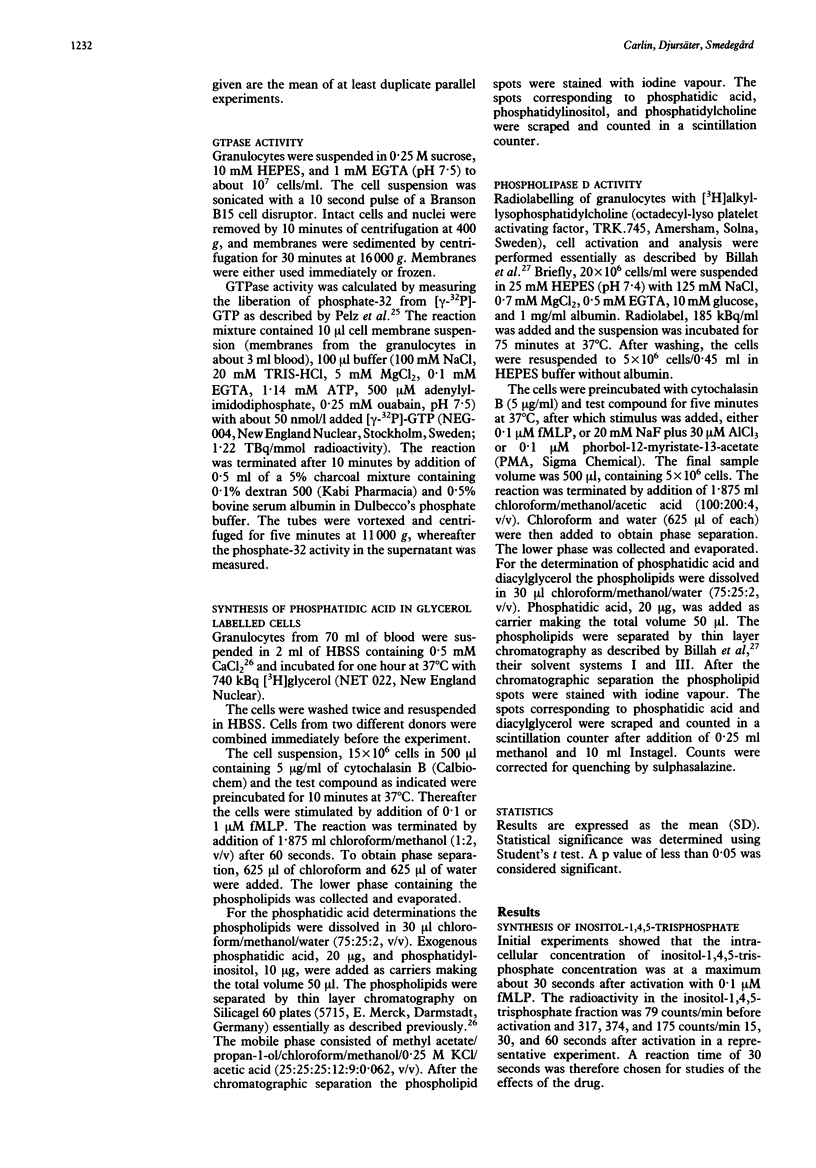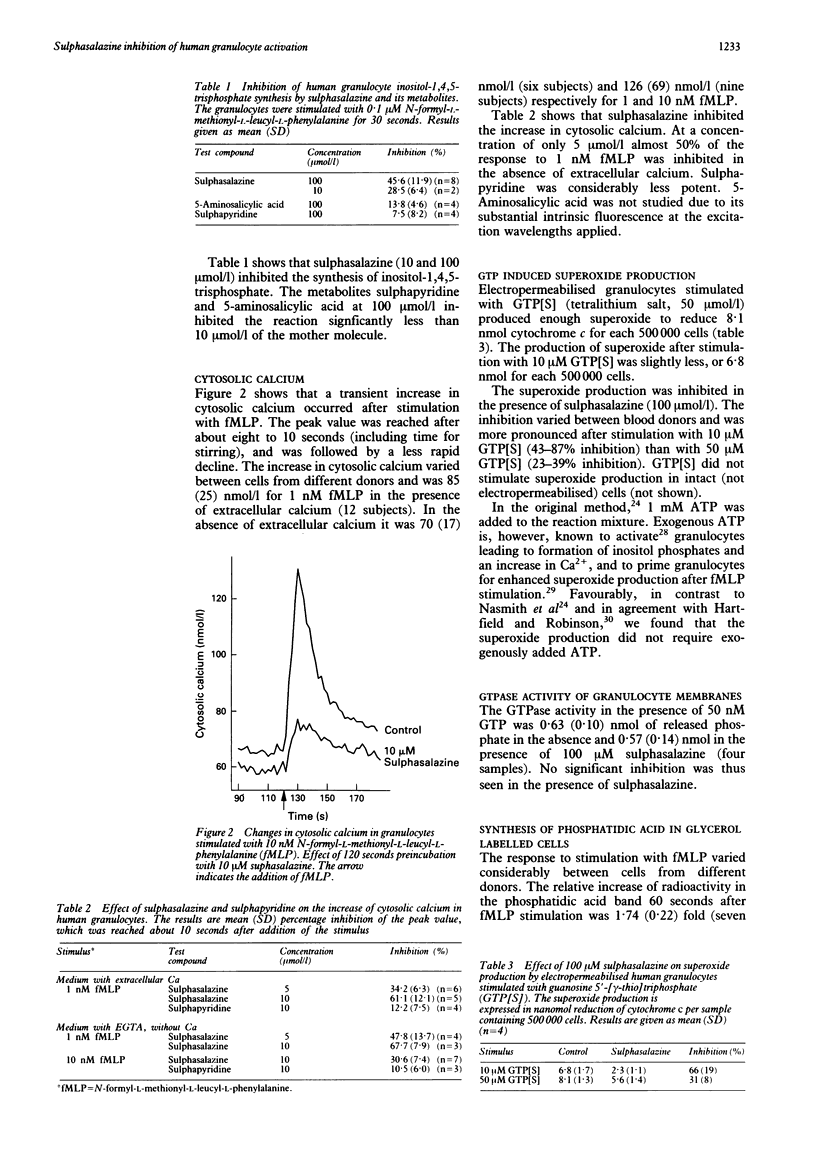Abstract
The effects of sulphasalazine on the production of second messenger compounds in human granulocytes have been characterised by various stimuli. The increases in cytosolic calcium, inositol trisphosphate, diacylglycerol, and phosphatidic acid (all important mediators of intracellular signal transduction) triggered by stimulation were inhibited by sulphasalazine. The metabolites 5-amino-salicylic acid and sulphapyridine were less potent inhibitors than the mother compound. It is concluded that sulphasalazine inhibits the synthesis of phosphoinositide derived second messenger compounds at the level of phospholipase C or its regulatory guanosine 5'-triphosphate (GTP) binding protein. Inhibition of phosphatidic acid synthesis was either due to the same mechanism, or to interaction with a phospholipase D regulating GTP binding protein.
Full text
PDF






Selected References
These references are in PubMed. This may not be the complete list of references from this article.
- Abramson S. B., Leszczynska-Piziak J., Haines K., Reibman J. Non-steroidal anti-inflammatory drugs: effects on a GTP binding protein within the neutrophil plasma membrane. Biochem Pharmacol. 1991 Jun 1;41(11):1567–1573. doi: 10.1016/0006-2952(91)90155-x. [DOI] [PubMed] [Google Scholar]
- Agwu D. E., McPhail L. C., Chabot M. C., Daniel L. W., Wykle R. L., McCall C. E. Choline-linked phosphoglycerides. A source of phosphatidic acid and diglycerides in stimulated neutrophils. J Biol Chem. 1989 Jan 25;264(3):1405–1413. [PubMed] [Google Scholar]
- Agwu D. E., McPhail L. C., Sozzani S., Bass D. A., McCall C. E. Phosphatidic acid as a second messenger in human polymorphonuclear leukocytes. Effects on activation of NADPH oxidase. J Clin Invest. 1991 Aug;88(2):531–539. doi: 10.1172/JCI115336. [DOI] [PMC free article] [PubMed] [Google Scholar]
- Berridge M. J., Irvine R. F. Inositol trisphosphate, a novel second messenger in cellular signal transduction. Nature. 1984 Nov 22;312(5992):315–321. doi: 10.1038/312315a0. [DOI] [PubMed] [Google Scholar]
- Billah M. M., Anthes J. C. The regulation and cellular functions of phosphatidylcholine hydrolysis. Biochem J. 1990 Jul 15;269(2):281–291. doi: 10.1042/bj2690281. [DOI] [PMC free article] [PubMed] [Google Scholar]
- Billah M. M., Eckel S., Mullmann T. J., Egan R. W., Siegel M. I. Phosphatidylcholine hydrolysis by phospholipase D determines phosphatidate and diglyceride levels in chemotactic peptide-stimulated human neutrophils. Involvement of phosphatidate phosphohydrolase in signal transduction. J Biol Chem. 1989 Oct 15;264(29):17069–17077. [PubMed] [Google Scholar]
- Carlin G., Djursäter R., Smedegård G. Inhibitory effects of sulfasalazine and related compounds on superoxide production by human polymorphonuclear leukocytes. Pharmacol Toxicol. 1989 Aug;65(2):121–127. doi: 10.1111/j.1600-0773.1989.tb01141.x. [DOI] [PubMed] [Google Scholar]
- Cockcroft S., Stutchfield J. ATP stimulates secretion in human neutrophils and HL60 cells via a pertussis toxin-sensitive guanine nucleotide-binding protein coupled to phospholipase C. FEBS Lett. 1989 Mar 13;245(1-2):25–29. doi: 10.1016/0014-5793(89)80184-x. [DOI] [PubMed] [Google Scholar]
- Comer S. S., Jasin H. E. In vitro immunomodulatory effects of sulfasalazine and its metabolites. J Rheumatol. 1988 Apr;15(4):580–586. [PubMed] [Google Scholar]
- Cross A. R. Inhibitors of the leukocyte superoxide generating oxidase: mechanisms of action and methods for their elucidation. Free Radic Biol Med. 1990;8(1):71–93. doi: 10.1016/0891-5849(90)90147-b. [DOI] [PubMed] [Google Scholar]
- Della Bianca V., De Togni P., Grzeskowiak M., Vicentini L. M., Di Virgilio F. Cyclic AMP inhibition of phosphoinositide turnover in human neutrophils. Biochim Biophys Acta. 1986 May 29;886(3):441–447. doi: 10.1016/0167-4889(86)90180-1. [DOI] [PubMed] [Google Scholar]
- Fujiwara M., Mitsui K., Yamamoto I. Inhibition of proliferative responses and interleukin 2 productions by salazosulfapyridine and its metabolites. Jpn J Pharmacol. 1990 Oct;54(2):121–131. doi: 10.1254/jjp.54.121. [DOI] [PubMed] [Google Scholar]
- Grynkiewicz G., Poenie M., Tsien R. Y. A new generation of Ca2+ indicators with greatly improved fluorescence properties. J Biol Chem. 1985 Mar 25;260(6):3440–3450. [PubMed] [Google Scholar]
- Gupta A. K., Ellis C. N., Siegel M. T., Duell E. A., Griffiths C. E., Hamilton T. A., Nickoloff B. J., Voorhees J. J. Sulfasalazine improves psoriasis. A double-blind analysis. Arch Dermatol. 1990 Apr;126(4):487–493. [PubMed] [Google Scholar]
- Harnett M. M., Klaus G. G. G protein regulation of receptor signalling. Immunol Today. 1988 Oct;9(10):315–320. doi: 10.1016/0167-5699(88)91325-4. [DOI] [PubMed] [Google Scholar]
- Hartfield P. J., Robinson J. M. Fluoride-mediated activation of the respiratory burst in electropermeabilized neutrophils. Biochim Biophys Acta. 1990 Sep 1;1054(2):176–180. doi: 10.1016/0167-4889(90)90239-a. [DOI] [PubMed] [Google Scholar]
- Hurst N. P., French J. K., Gorjatschko L., Betts W. H. Studies on the mechanism of inhibition of chemotactic tripeptide stimulated human neutrophil polymorphonuclear leucocyte superoxide production by chloroquine and hydroxychloroquine. Ann Rheum Dis. 1987 Oct;46(10):750–756. doi: 10.1136/ard.46.10.750. [DOI] [PMC free article] [PubMed] [Google Scholar]
- Kanerud L., Hafström I., Ringertz B. Effect of sulphasalazine and sulphapyridine on neutrophil superoxide production: role of cytosolic free calcium. Ann Rheum Dis. 1990 May;49(5):296–300. doi: 10.1136/ard.49.5.296. [DOI] [PMC free article] [PubMed] [Google Scholar]
- Kitsis E., Weissmann G. The role of the neutrophil in rheumatoid arthritis. Clin Orthop Relat Res. 1991 Apr;(265):63–72. [PubMed] [Google Scholar]
- Korchak H. M., Vosshall L. B., Haines K. A., Wilkenfeld C., Lundquist K. F., Weissmann G. Activation of the human neutrophil by calcium-mobilizing ligands. II. Correlation of calcium, diacyl glycerol, and phosphatidic acid generation with superoxide anion generation. J Biol Chem. 1988 Aug 15;263(23):11098–11105. [PubMed] [Google Scholar]
- Korchak H. M., Vosshall L. B., Zagon G., Ljubich P., Rich A. M., Weissmann G. Activation of the neutrophil by calcium-mobilizing ligands. I. A chemotactic peptide and the lectin concanavalin A stimulate superoxide anion generation but elicit different calcium movements and phosphoinositide remodeling. J Biol Chem. 1988 Aug 15;263(23):11090–11097. [PubMed] [Google Scholar]
- Molin L., Stendahl O. The effect of sulfasalazine and its active components on human polymorphonuclear leukocyte function in relation to ulcerative colitis. Acta Med Scand. 1979;206(6):451–457. doi: 10.1111/j.0954-6820.1979.tb13545.x. [DOI] [PubMed] [Google Scholar]
- Nasmith P. E., Mills G. B., Grinstein S. Guanine nucleotides induce tyrosine phosphorylation and activation of the respiratory burst in neutrophils. Biochem J. 1989 Feb 1;257(3):893–897. doi: 10.1042/bj2570893. [DOI] [PMC free article] [PubMed] [Google Scholar]
- Neal T. M., Vissers M. C., Winterbourn C. C. Inhibition by nonsteroidal anti-inflammatory drugs of superoxide production and granule enzyme release by polymorphonuclear leukocytes stimulated with immune complexes or formyl-methionyl-leucyl-phenylalanine. Biochem Pharmacol. 1987 Aug 1;36(15):2511–2517. doi: 10.1016/0006-2952(87)90524-7. [DOI] [PubMed] [Google Scholar]
- Nishizuka Y. Studies and perspectives of protein kinase C. Science. 1986 Jul 18;233(4761):305–312. doi: 10.1126/science.3014651. [DOI] [PubMed] [Google Scholar]
- Okamoto M., Sasano M., Goto M., Nishioka K., Aotsuka S., Nakamura K., Yokohari R. Suppressive effect of anti-rheumatic drugs on interleukin-1 beta release from human peripheral blood monocytes. Int J Immunopharmacol. 1991;13(1):39–43. doi: 10.1016/0192-0561(91)90023-z. [DOI] [PubMed] [Google Scholar]
- Pelz C., Matsumoto T., Molski T. F., Becker E. L., Sha'afi R. I. Characterization of the membrane-associated GTPase activity: effects of chemotactic factors and toxins. J Cell Biochem. 1989 Feb;39(2):197–206. doi: 10.1002/jcb.240390211. [DOI] [PubMed] [Google Scholar]
- Peppercorn M. A. Sulfasalazine. Pharmacology, clinical use, toxicity, and related new drug development. Ann Intern Med. 1984 Sep;101(3):377–386. doi: 10.7326/0003-4819-101-3-377. [DOI] [PubMed] [Google Scholar]
- Rhodes J. M., Bartholomew T. C., Jewell D. P. Inhibition of leucocyte motility by drugs used in ulcerative colitis. Gut. 1981 Aug;22(8):642–647. doi: 10.1136/gut.22.8.642. [DOI] [PMC free article] [PubMed] [Google Scholar]
- Rossi F., Della Bianca V., Grzeskowiak M., Bazzoni F. Studies on molecular regulation of phagocytosis in neutrophils. Con A-mediated ingestion and associated respiratory burst independent of phosphoinositide turnover, rise in [Ca2+]i, and arachidonic acid release. J Immunol. 1989 Mar 1;142(5):1652–1660. [PubMed] [Google Scholar]
- Stenson W. F., Mehta J., Spilberg I. Sulfasalazine inhibition of binding of N-formyl-methionyl-leucyl-phenylalanine (FMLP) to its receptor on human neutrophils. Biochem Pharmacol. 1984 Feb 1;33(3):407–412. doi: 10.1016/0006-2952(84)90233-8. [DOI] [PubMed] [Google Scholar]
- Ward P. A., Cunningham T. W., Walker B. A., Johnson K. J. Differing calcium requirements for regulatory effects of ATP, ATP gamma S and adenosine on O2.- responses of human neutrophils. Biochem Biophys Res Commun. 1988 Jul 29;154(2):746–751. doi: 10.1016/0006-291x(88)90203-3. [DOI] [PubMed] [Google Scholar]
- Wright C. D., Kuipers P. J., Hoffman M. D., Thueson D. O., Conroy M. C. Inhibition of human neutrophil activation by the allergic mediator release inhibitor, CI-949: mechanism of inhibitory activity. Biochem Biophys Res Commun. 1990 Mar 16;167(2):828–834. doi: 10.1016/0006-291x(90)92100-e. [DOI] [PubMed] [Google Scholar]


